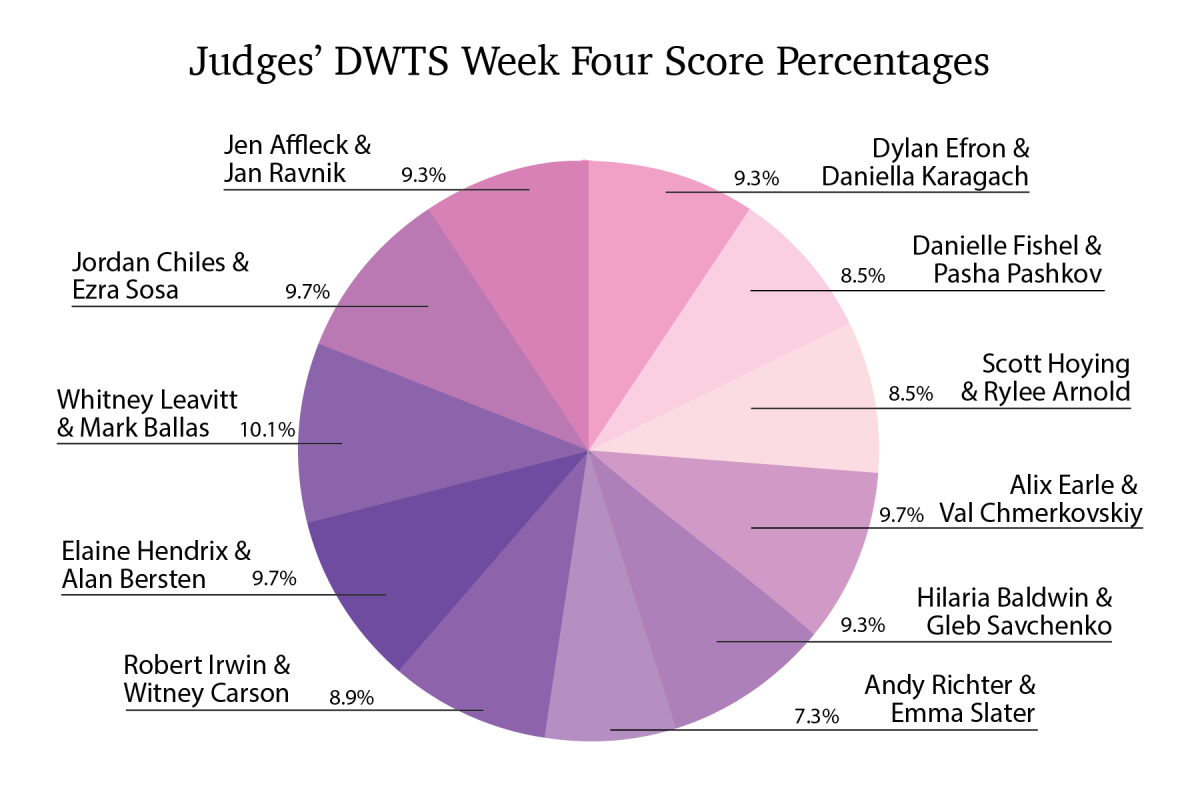I ran into two-time NBA all-star Baron Davis last week in SoHo. A month ago, I wouldn’t have recognized him, but that night I walked up to him and said, “I loved you on ‘Dancing with the Stars.’”
Unfortunately, Davis was one of the first stars to get eliminated this season — a surprise to me, because I thought he showed quite promising potential compared to basketball players in the show’s past (I’m looking at you, Dwight Howard). Yes, Davis might have made a few missteps in his routine, but do you want to know the real reason I think he got the boot so early? An unfair scoring system.
For those unfamiliar, “Dancing with the Stars” (DWTS) pairs celebrities — actors, singers, athletes, etc. — with professional ballroom dancers to perform choreographed routines each week. Judges’ scores and audience votes (cast through text) determine who stays in the competition and who is eliminated.
And this system has time and time again led better dancers to be eliminated before those with more star power and relevance.
Fans have long criticized the competition for being a contest of popularity rather than talent. Many attribute this to the show’s resurgence in the age of social media, but the scoring system has been the same since its inception in 2005 — a 50-50 split between judges’ scores and audience votes. And this system has time and time again led better dancers to be eliminated before those with more star power and relevance.
In the end, the fact that I hadn’t heard of Baron Davis before this season says it all — his downfall wasn’t about talent, but about visibility.
One might assume that a 50-50 split between judges’ scores and audience votes would be the fairest system. In practice, however, the judges’ scores often fail to differentiate between contestants who are objectively performing well. Week after week, most performers land in the same narrow range — typically sixes, sevens or eights — not because they’re equally skilled, but because the system lacks nuance. This compresses the leaderboard and diminishes the impact of the judges’ scores, leaving the audience vote to carry far more weight than intended.
In week four of this season, eight out of the 11 couples scored between 22 out of 30 and 25 out of 30. These scores are divided by the total number of points given that night (in this case: 248), translating into a percentage that contributes to their overall standing. A couple with a score of 22 out of 30 would receive 8.87%, and a couple who scores 25 out of 30 would receive 10.08%. They’re only separated by less than 1.3% in the end.
The show’s credibility and fairness would benefit from a clearer structure that holds both judges and contestants to the same standard.
When it comes to audience votes, however, the gap widens significantly. Out of 50 million total audience votes — the record-breaking number the show saw for the first time this season — a couple earning seven million votes would hold 14% of the total, while a couple earning 10 million would reach 20%. That 6% difference can easily outweigh the narrow margin from the judges and ultimately decide who stays or goes.
One of the most controversial winners in the show’s history was Bobby Bones, an American radio and television personality who openly referred to himself as “the worst dancer” of his season. Despite earning some of the lowest scores from the judges week after week, he still walked away with the Mirrorball Trophy — thanks to a dedicated fan base that voted for him.
I’m not suggesting that audience votes shouldn’t matter, but I do believe a 70-30 split would create a fairer balance. With this system, stars would need strong judges’ scores just as much as a significant number of audience votes to advance.
But of course, this adjustment wouldn’t solve every issue — giving more weight to the judges’ scores would also require them to refine their scoring methods.
Over the past 20 years and 34 seasons that DWTS has been around, the judges have scored based on no concrete rubric or criteria; their experience in the industry alone qualifies them to score based on their knowledge and how well, in their opinion, the stars execute the styles.
The current judging panel includes Carrie Ann Inaba, a former professional dancer and choreographer who has been a judge since the show’s debut in 2005; Bruno Tonioli, an Italian choreographer known for his work with Tina Turner and Michael Jackson, who has also been on the panel since the beginning; and Derek Hough, who joined as a judge in 2020 after a highly successful run as a professional dancer on the show, winning the Mirrorball Trophy a record six times.
Still, even with that level of expertise at the table, the scoring often feels inconsistent. Viewers are left wondering what, exactly, earns a “nine” instead of an “eight,” or why one mistake is penalized while another is overlooked. The show’s credibility and fairness would benefit from a clearer structure that holds both judges and contestants to the same standard.
If I were in charge, I’d propose a scoring system that evaluates four key elements — improvement, technique, difficulty (of choreography) and performance. Each would be scored out of 10 and then averaged to determine the couple’s final score.
Scoring on improvement would tackle one of the show’s longest-standing critiques: the unfair advantage of casting celebrities with prior dance experience. By rewarding growth rather than perfection, it levels the playing field and highlights the effort of contestants starting from scratch.
This issue has surfaced season after season. TikTok star Charli D’Amelio, who took home the Mirrorball Trophy in season 31, faced backlash for her extensive dance background. The then 18-year-old had been performing since she was three and brought over a decade of competitive dance experience to the show.
Tackling challenging routines highlights the commitment and courage of contestants and should be recognized just as much as proper execution.
This season, contestants Whitney Leavitt and Hilaria Baldwin have received similar backlash. Leavitt, a former dancer and cheerleader, holds a bachelor’s degree in dance from Brigham Young University, while Baldwin’s case is even more controversial — she competed in ballroom professionally as a young adult.
In fact, a user on X discovered that Baldwin competed in Blackpool Dance Festival — the world’s most famous annual ballroom dance competition — in 2004, and actually placed higher than the current pro-dancer on the show, Emma Slater. For this reason, I view Baldwin’s casting as particularly problematic and an outlier to my proposed framework.
That said, celebrities with dance backgrounds, such as D’Amelio and Leavitt, have trained in contemporary or commercial dance styles — not ballroom. This distinction matters. Ballroom requires an entirely different skill set, from posture and frame to footwork and partner connection. Including technique as an element for scoring would ensure that contestants are judged on how well they adapt to the specific demands of ballroom dance, rather than on their pre-existing familiarity with other genres.
Continuing on, scoring on difficulty rewards couples who take on more ambitious choreography. Tackling challenging routines highlights the commitment and courage of contestants and should be recognized just as much as proper execution. Additionally, I believe it would bring more excitement to the ballroom, encouraging pros to take more creative risks and introduce greater innovation to the stage.
Judges shouldn’t be afraid to give out twos and threes in the beginning weeks, and giving out a 10 should really mean something — not just be a standard by the end of each season.
Lastly, there’s performance, an element that any celebrity can excel at regardless of experience. Scoring on performance recognizes not just how well someone moves, but how well they sell the dance — their facial expressions, confidence and chemistry with their partner. After all, that’s what keeps audiences tuning in to DWTS: to see people we know and love step outside their comfort zones, put on a show and have fun doing it.
With this proposed criteria, I think we’d see a fuller range of paddles other than the consistent sixes, sevens and eights we’ve been seeing this season. Judges shouldn’t be afraid to give out twos and threes in the beginning weeks, and giving out a 10 should really mean something — not just be a standard by the end of each season.
Reintroducing half-point scores could also go a long way in creating more distinct differentiation between couples. Right now, a performance that feels slightly stronger or weaker often ends up with the same whole-number score, which doesn’t accurately reflect the nuances the judges themselves often point out.
Interestingly, showrunners experimented with this idea once before, during its all-star season (season 15), to “allow judges to make finer distinctions between performances.” The change made sense at the time — that season featured some of the most technically skilled contestants the show had ever seen — but it’s unclear why the format didn’t stick.
If anything, the same logic should apply to every season. Even among less experienced celebrity contestants, there are often subtle differences in execution, musicality and overall performance quality that whole numbers simply can’t capture.
In the past, showrunners also explored the idea of the judges’ save, which ruled that the 50-50 split between judges’ scores and audience votes determined the bottom two couples of each week, but the judges would make the final decision of which couple was eliminated. This structure was introduced in season 28 after the aforementioned, highly controversial Bobby Bones win, but it only lasted four seasons before reverting back.
Executive Producer Deena Katz admitted that the judges’ save diminished the impact of viewers’ votes, and I tend to agree. Fans tune in to DWTS not just to watch routines, but to have a meaningful say in who stays and who goes — we just don’t need to have the only say.
With the help of a more rigid rubric and a rebalanced scoring split, fans could continue to vote with their hearts and the judges with their heads.
And as a longtime fan of the show, I must say, I am begging those judges to use their heads a little more. Between Bruno gyrating through critiques, Derek’s overly cautious niceties and Carrie Ann’s misogynistic tendencies, it might be time for a little cleanup behind the desk. If I really were newly in charge, I might consider a “spill and fill,” but that’s a battle for another byline. For now, let’s just agree — a few guidelines could go a long way.


